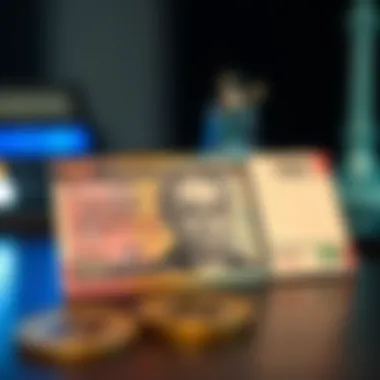Exploring Venezuelan Banknotes: History and Impact


Intro
In a world swirling with financial turbulence, Venezuelan banknotes serve as both artifacts of history and reflections of contemporary societal struggles. They narrate tales of economic highs and lows, intertwined with the very fabric of national identity. Amidst the hyperinflation that has gripped Venezuela, the evolution of these banknotes provides more than just a visual or monetary perspective—it sheds light on the daily lives of people navigating through relentless economic challenges.
Exploring the history and transformation of these notes reveals their significance far beyond mere currency. The intricate designs encapsulate cultural references and monumental figures, while their very existence captures the journey of a country striving for stability in the face of adversity. In this analysis, we will delve into the dynamics influencing the creation and value of these banknotes, how they resonate with citizens, and what they signify for the nation as a whole.
From the origins of physical currency in Venezuela to the tumultuous current state, this exploration aims to enrich the understanding of the reasons behind the designs, the people they honor, and the broader socioeconomic impacts they encapsulate. The banking systems, inflation rates, and even the art on the notes tell a story that is crucial for investors, educators, students, and analysts seeking insights into the heart of Venezuela's economic landscape.
The Historical Context of Venezuelan Currency
Understanding the historical context of Venezuelan currency is crucial in grasping the intricacies of its current socioeconomic landscape. This section aims to shed light on how the evolution of currency has profoundly influenced not just the economy, but also the national identity and cultural narratives of Venezuela. Each phase of currency transformation tells a story about the people, their struggles, and the systems in place that shaped their financial realities. As we delve into the evolution of currency through historical lenses, it becomes evident how the past shapes contemporary financial challenges.
Pre-Colonial Currency Practices
Before Spanish colonization, the indigenous people of what is now Venezuela utilized various items as a medium of exchange. Cacao beans, for example, were highly valued and often used in trade. This practice showcased a deep understanding of economic principles, albeit in a rudimentary manner. Local tribes traded goods such as pottery, textiles, and even certain foodstuffs without a standardized system, relying heavily on barter.
Although these practices might seem primitive by today's standards, they served the communities well, allowing trade to flourish despite the absence of a formal currency. Notably, different regions had unique methods, reflecting their distinct cultures and resources. For instance, coastal tribes might trade fish for agricultural products with inland tribes, offering a glimpse into complex trade networks.
Colonial Influence on Currency Systems
The arrival of the Spanish in the 16th century marked a significant turning point in Venezuela's currency evolution. The colonial powers introduced their own monetary systems, primarily based on precious metals. The real de a ocho, or pieces of eight, became popular. This coin was made from silver and was widely accepted throughout Spanish colonies. Consequently, the indigenous methods of exchange were largely overshadowed.
Compounding this issue, the colonial administration imposed taxes, often demanding payment in these foreign coins. This not only disrupted local economies but also alienated the indigenous population. The reliance on these metal coins highlighted the budding conflict between colonial interests and local economies, setting a precedent for economic disparities that would persist long after independence.
Emergence of the Bolívar
The 19th century witnessed the birth of a new currency that was deeply rooted in the struggle for independence: the Bolívar. Named after Simón Bolívar, a pivotal figure in Latin American history, this currency emerged as more than just legal tender; it symbolized national pride and unity following the tumult of colonial rule.
The Bolívar was introduced in 1879, aiming to unify the fragmented economic practices left in the wake of colonialism. Initially based on the gold standard, it sought to stabilize the economy. However, as political instability crept back in, the Bolívar's value began to fluctuate. Over time, various denominations and designs reflected Venezuela’s changing political landscapes, often becoming a repository of national identity and sentiment.
The shift towards the Bolívar also illustrated broader economic theories in practice, such as the balance between supply, demand, and the intrinsic value of currency. The currency's evolution from being backed by gold to more abstract economic factors serves as a pivotal lesson in understanding inflation and financial policies.
In summary, the historical context of Venezuelan currency, from pre-colonial barter systems to the rise of the Bolívar, unravels the intricate relationship between economics and national identity. Each step signifies not just a change in transaction methods but also evolving cultural significances and socio-economic structures that continue to shape Venezuela today.
Evolution of Venezuelan Banknotes
The evolution of Venezuelan banknotes is a window into the nation's economic history and societal values. From their inception to their current state, these notes not only represent currency but also mirror the struggles and triumphs of Venezuela as a nation. Understanding this evolution is vital as it encapsulates how economic forces, political decisions, and cultural narratives intertwine to affect everyday life in Venezuela.
The First Bolívar Banknotes
The first Bolívar banknotes made their appearance in the 19th century, named after Simón Bolívar, a key figure in the fight for Latin American independence. These notes were initially backed by the country's gold and silver reserves, giving them a robust foundation. Each banknote featured intricate designs, often depicting notable figures from the independence era and emblematic symbols of Venezuelan identity.
This early issuance signified more than just a medium of exchange; it marked a cultural renaissance, a way of establishing a national identity post-colonization. The designs were carefully crafted to inspire pride and unity among citizens as they sought to build a collective future after years of struggle. Yet, it is crucial to understand that these early notes faced challenges too, such as counterfeiting and a fluctuating economy which would prove problematic in years to come.
Changes Through The Decades
As decades rolled on, the Bolívar underwent numerous transformations. The first major change came in the mid-20th century when new designs were introduced to reflect modernity and progress. Banknotes began to showcase not just historical figures but also elements of Venezuelan culture, landscapes, and achievements.


However, the 21st century brought something more tumultuous. Political strife and economic mismanagement intensified, leading to rampant inflation and the gradual erosion of the Bolívar's value. Wealthy individuals, businesses and everyday Venezuelans found themselves grappling with diminishing purchasing power. Consequently, numerous denominations were issued within a short time, attempting to keep pace with inflation, often rendering previous designs obsolete almost overnight. While some banknotes featured beautiful artwork and symbolism, they quickly lost value, leading to confusion and mistrust among the public.
Foreword of the New Bolívar
In response to the spiraling economic crisis, the Venezuelan government introduced the ‘New Bolívar’ in 2018, effectively redenominating the currency by removing five zeros from the original Bolívar. This change aimed to simplify transactions and restore some level of confidence in the currency. The redesign focused on a fresh aesthetic, with vibrant colors and depictions of famous Venezuelan cultural figures.
Though the New Bolívar came with promises of stabilization, it essentially represented a stopgap measure amid persisting hyperinflation. Many Venezuelans remained skeptical of the efficacy of these reforms.
As the country struggles to navigate these turbulent waters, the evolution of the Bolívar stands as a testament to the resilience of the Venezuelan people. It urges them to reflect not only on their monetary systems but also on their collective identity, societal norms and cultural aspirations.
"Banknotes telling stories of a nation—each bill a chapter in Venezuela's continuous narrative of hope and hardship."
In understanding how these banknotes evolved, it allows us to grasp the intertwined relationship between currency and national identity. The journey of the Bolívar reveals much about the resilience and challenges faced by a country striving for economic recovery even amid severe adversities.
Design Features of Current Banknotes
The design features of Venezuelan banknotes are pivotal in communicating the nation’s identity, aspirations, and historical narrative through currency. More than just mere legal tender, these banknotes encapsulate a country’s soul, reflecting its cultural values and struggles amidst economic upheavals. In the context of Venezuela, where hyperinflation has drastically altered perceptions of value, the design attributes become particularly significant as they offer insights into the societal and economic landscape. Understanding these features provides a deeper appreciation of how currency can shape and mirror national conversations.
Color Schemes and Artistic Elements
Contemporary Venezuelan banknotes boast a variety of vibrant color schemes that distinguish each denomination. This intentional choice of hues is no mere aesthetic whim; rather, it ties into historical and cultural contexts. For instance, the 100 Bolívar note prominently displays a green coloration which symbolizes wealth and growth, while the 10,000 Bolívar note features a striking blue that evokes the country’s natural resources, particularly the extensive bodies of water. Each note's artistic element is typically rooted in significant Venezuelan achievements and icons, creating a narrative tapestry through color.
- Frontal Design: The front of the banknote often showcases prominent figures in Venezuelan history or culture. Figures such as Simón Bolívar serve not only as a reminder of national pride but also instill a sense of unity among citizens.
- Theming: The colors are often bright, reflecting the vivacity of Venezuelan culture and lifestyle. Each change is significant, thus reinforcing its relevance to the people.
These colors can stir emotions and connect citizens with their heritage. Selecting hues that resonate with the populace might uplift spirits amid economic adversity.
Imagery and Symbolism
Diving deeper into the imagery presented on Venezuelan banknotes reveals layers of symbolism that articulate both the nation’s heritage and its aspirations. Imagery isn’t random; it's quite calculated. For example, the 20 Bolívar bill showcases a condor, symbolizing freedom and resilience. Such symbolic representations remind the populace of cultural values and the natural beauty of the land.
Additionally, these banknotes reflect events that shape the Venezuelan narrative conferring a dual purpose; they function as both currency and storytellers.
- Natural Elements: Many banknotes feature flora and fauna endemic to Venezuela, creating a visual connection to its rich biodiversity. This not only serves to celebrate the natural wealth of Venezuela but also emphasizes the importance of environmental conservation.
- Cultural Handcrafts: Symbols of local crafts and traditional art appear on banknotes, illustrating the creativity inherent to Venezuelan society.
Through these carefully chosen elemnts, the banknotes assert a sense of pride in Venezuelas past while encouraging a collective vision for the future.
Security Features
In the throes of hyperinflation and the accompanying challenges of counterfeiting, security features of the current Venezuelan banknotes have become paramount. These features not only protect the integrity of the currency but also instill confidence among users.
- Watermarks: Each banknote includes a watermark of relevant historical figures, an essential feature that aids in distinguishing real currency from fakes.
- Microprinting: Fine lettering that is often hard to replicate serves as an additional safeguard against counterfeiting.
- Color-Shifting Ink: Notably, certain banknotes incorporate color-shifting ink that changes hue when viewed from different angles, making duplication an arduous task.
Such features are crucial given the economic climate in Venezuela. They protect the dignity of the currency amidst turmoil, reassuring the public with tangible evidence of worth.
Hyperinflation and Its Effects on Currency
Hyperinflation is a pivotal part of Venezuela’s economic narrative. Understanding this phenomenon provides deeper insights into how Venezuelan banknotes have evolved and morphed amidst economic challenges. The intertwining of hyperinflation with currency not only signals financial instability but also helps to unpack the socioeconomic fabric of society.


Understanding Hyperinflation in Venezuela
Venezuela's experience with hyperinflation is often cited as one of the worst in history. Starting primarily in the mid-2010s, the nation found itself caught in a whirlwind of soaring prices that left the currency practically worthless.
The consumer price index (CPI) reflects this stark reality, with increases sometimes hitting over fifty percent in a single month. At this pace, it becomes clear why the average citizen struggles to manage a budget. What once cost a few bolívares now can skyrocket to hundreds or even thousands. This dramatic devaluation compels individuals to constantly adjust their financial strategies, leading to reliance on foreign currency, particularly the US dollar.
Moreover, a major driver of hyperinflation in Venezuela is linked to government monetary policy. With the government printing excessive amounts of currency to cover budget deficits, the laws of supply and demand push the value of the bolívar further down into the abyss. This also breeds a culture of mistrust in the currency itself, compelling citizens to seek stability elsewhere.
Impact on Banknote Value and Circulation
As hyperinflation continues its rampage, the direct fallout on banknotes becomes apparent. With the value of the bolívar diminishing, more and more zeros are added to banknotes. The bolívar fuerte, launched in 2008, was reintroduced as the bolívar soberano in 2018, effectively lopping five zeros off the prior currency. But this cosmetic change didn’t bring about any real change in purchasing power. The purchasing capacity of the bolívar has eroded significantly, leading to confusion and chaos regarding the value of money.
- Banknotes under hyperinflation become cumbersome. A shopping trip might require carrying stacks of bills, yet those bills hold little negotiating power. The practicality of cash becomes questionable as many merchants resort to refusing cash payments altogether, preferring the stability of foreign currencies.
- Consumer behavior shifts during intense periods of inflation. People start to favor barter systems for daily needs. In worst-case scenarios, some may even bypass the currency altogether, opting for alternatives like food, fuel, or even services. This has direct implications on how economic exchanges are conducted in everyday life.
Comparative Analysis with Other Nations
Venezuela is not alone in facing hyperinflation; however, its unique context sets it apart from comparable situations in other nations. Looking at Zimbabwe during the late 2000s or Germany in the 1920s offers parallels.
- In Zimbabwe, hyperinflation peaked in 2008, where it was eventually considered necessary to abandon the local currency in favor of foreign alternatives. Just as in Venezuela, the ramifications extended beyond economics, affecting social trust and national identity.
- Germany’s Weimar Republic also fell victim to rampant inflation after World War I. While the hyperinflation of that period is often cited in textbooks, it serves as a reminder that historical trajectories can illuminate present scenarios. Unlike Venezuela, post-WWI Germany ultimately restructured its economy through the introduction of a new stable currency.
Venezuela’s case shines a light on the profound implications of hyperinflation on identity and inclusion in the global economy. The effects stretch beyond mere numbers on currency and touch the lives of every Venezuelan. For those studying the interplay of finances, society, and history, the lessons drawn from Venezuela may serve as a cautionary tale.
Understanding hyperinflation goes beyond economic theory; it's about grasping a shared experience that reshapes every facet of life.
By examining these factors, one can vividly appreciate why hyperinflation isn’t just an economic condition; it's a force of societal transformation, influencing how citizens interact with currencies and each other.
Sociocultural Implications of Banknotes
The interplay between currency and culture can tell us a great deal about a nation’s identity and values. In Venezuela, banknotes do more than simply serve as a medium of exchange; they encapsulate the heartbeat of a society grappling with economic strife, while also reflecting a rich tapestry of cultural history. Understanding the sociocultural implications of Venezuelan banknotes enables one to grasp the deeper connections between currency design, public sentiment, and national pride.
Banknotes as Reflections of National Identity
Venezuelan banknotes serve as vehicles for expressing national identity. Each bill crafted over the years has been designed with specific imagery and symbolism that resonates with the Venezuelan populace. The very choice of portraits, landmarks, and symbols does not arise by chance; they aim to invoke feelings of pride and belonging.
- Cultural Icons: Portraits of notable historical figures like Simón Bolívar have adorned the money, grounding the currency in a sense of patriotic history. Such choices aren't just decorative; they lead to a communal recognition of shared sacrifices and accomplishments that define Venezuelan identity.
- Landscape and Heritage: Elements like mountain ranges, flora, and fauna often appear on the bills, which not only celebrate the country’s biodiversity but also its geographical uniqueness. This is a reminder of the diverse ecosystems that the Venezuelans inhabit, fostering a sense of unity within the community.
In the context of hyperinflation, the increasing difficulty of obtaining these banknotes can lead to a hesitate to let go of them, thus elevating their status beyond mere currency to cherished mementos. The psychological effects of these associations are strong indicators of how money can entwine with identities, making it clear that our interaction with currency can be far more than transactional.
Cultural Representations in Banknote Design
The artistry involved in Venezuelan banknote design showcases an intricate blend of cultural heritage and modern interpretation. Designers are faced with the challenge of creating banknotes that are both functional and culturally significant.
- Artistic Trends: Colors, patterns, and artistic styles employed often reflect contemporary Venezuelan art movements that contribute to national narratives. The shifts in design can also be seen as a reflection of changing societal values and aspirations. For instance, vibrant colors might signify hope and resilience during turmoil.
- Cultural Symbols: Beyond imagery, cultural symbols embedded in the designs—such as the national flower or the coat of arms—serve to remind individuals of collective history and pride. The stories told through these designs resonate with both the young and the old, reinforcing a sense of cultural continuity.
One cannot overlook the way these elements play a crucial role in educating future generations about their lineage, fostering a sense of responsibility to preserve their cultural identity.
Public Perception of Currency Amid Crisis


The ongoing economic crisis has drastically altered the public’s perception of Venezuelan banknotes. Once considered symbols of pride, they now often represent struggle and anxiety for many.
- Trust Erosion: The rampant hyperinflation has caused the value of banknotes to plummet, leading to a significant erosion of trust in the currency system as a whole. People often joke that the only use of money in stores is to weigh it, indicating how it’s better suited for heft than value. This sentiment has led to alternative means of trade, including barter systems.
- Psychological Impact: The emotional toll on individuals is palpable. The daily challenges of finding enough cash for transactions lead to frustration, while the constant devaluation creates a sense of instability that pervades everyday life.
The Future of Venezuelan Banknotes
As Venezuela continues to navigate the turbulent waters of economic instability, the future of its banknotes remains a crucial topic of discussion. In the face of rampant hyperinflation and currency devaluation, the resilience and adaptability of the Venezuelan bolívar will be tested. This section explores how economic reforms, digital currency options, and innovative strategies may pave the way toward stabilizing the nation's monetary system.
Prospects for Currency Stabilization
The potential for stabilizing the Venezuelan currency lies not only in addressing inflation but also in restoring public trust in the financial system. Historically, monetary stability often correlates with confidence from citizens and investors alike.
- Strategic Reforms: Implementing sound monetary policies is pivotal. These could include the introduction of a new currency backed by tangible reserves or strict monetary limits to control inflation. The government must work closely with international financial institutions to ensure transparency and feasibility in financial reforms.
- Public Dialogue: Engaging citizens in discussions about the monetary system can foster a sense of ownership and credibility. By practicing openness and accountability, state officials might gradually restore trust. Regular updates and educational initiatives about currency handling could shift perceptions positively.
- Foreign Investments: Attracting foreign investment is another keystone for currency stabilization. When investors see a commitment to reforms, they may find a renewed interest in Venezuela’s market.
"When a country's currency loses its value, it influences not just market transactions, but fundamental social structures and relations."
Potential Reforms and Innovations
Exploring reforms requires understanding the challenges faced. Therefore, both innovative approaches and traditional reforms must work hand in hand to alleviate the ongoing crisis.
- Improved Monetary Policy: A shift toward a controlled monetary framework might include establishing stringent regulations on money supply, aiming to counteract inflationary pressures.
- Banknote Redesign: In a deteriorating economy, introducing new banknote designs could also signify a fresh start. Reimagining banknotes with updated security features and modern graphics may encourage acceptance from the public while savy corrections are made to previously corrupted systems.
- Incentives for Local Business: Promoting localized currencies or vouchers for local transactions might bolster community economies. Such initiatives can drive demand for goods and services within Venezuela.
Digital Currency Considerations
The rise of digital currency presents both challenges and opportunities for bolívar’s future. Embracing technological advancements could provide the necessary infrastructure for addressing longstanding monetary issues.
- Cryptocurrency Adoption: As a direct counter to hyperinflation, cryptocurrencies like Bitcoin have emerged as an alternative medium of exchange for many Venezuelans. National adaptation of digital currencies could lead to more stable transaction methods.
- Blockchain Integration: Implementing blockchain technology may improve currency tracking and security, reducing corruption and ensuring transparency. A digital bolívar could utilize decentralized finance systems to facilitate transactions without government interference.
- International Partnerships: Forming relationships with tech companies specializing in digital currencies may bolster existing financial frameworks and offer innovative solutions to Venezuela. Global collaborations could also aid in decreasing reliance on foreign currency reserves.
Closure: Reflections on Venezuelan Currency
The exploration of Venezuelan currency goes beyond mere material value; it encapsulates the essence of a nation grappling with profound economic shifts. Currency isn't just a tool for exchange; it emerges as a symbol of identity and resilience amid dire circumstances. This final section synthesizes critical insights from the discussion of Venezuelan banknotes, reinforcing their significant role in the economic and cultural landscape of the country.
Summary of Key Points
Over the course of this analysis, several key themes have emerged:
- Historical Evolution: Venezuelan currency has transitioned from indigenous barter systems to the introduction of the Bolívar, highlighting the influence of colonial powers and economic necessity.
- Hyperinflation's Impact: The hyperinflation crisis has drastically altered the value and circulation of banknotes, rendering many denominations nearly worthless while forcing a high dependence on foreign currencies.
- Cultural Representation: The design elements found in contemporary banknotes reflect Venezuela's rich history and cultural tapestry, serving as a mirror of national identity during turbulent times.
- Future Prospects: As discussions on currency stabilization and digital alternatives develop, the future of Venezuelan banknotes remains uncertain yet ripe for innovative solutions.
Each of these points weaves together a narrative that not only illustrates a nation in turmoil but also shows the resilience and adaptability inherent in its people and systems.
The Role of Banknotes in Economic Discourse
Banknotes are not simple pieces of paper; they represent trust in the economy and reflect the socio-political climate. In Venezuela, the physical currency underwent a transformation that emphasizes the overarching economic discourse. They symbolize the purchasing power a household possesses and act as a testament to governmental efficacy in monetary policy.
In analyzing the rhetorical nature of these banknotes, we see that:
- Trust and Value: The fluctuating value of the Bolívar illustrates the citizen's waning confidence in their currency, echoing broader conversations about governance and fiscal responsibility.
- Public Sentiment: The way people perceive their currency speaks volumes about their sense of national identity and future prospects. Neglect or admiration for banknotes acts as a narrative about resilience against pervasive economic challenges.
- Cultural Discourse: The symbolism embedded in designs can be interpreted as both a unifying force and a point of contention. It evokes discussions regarding representation, history, and the evolving narrative of Venezuelan society.
In summary, the reflections on Venezuelan currency reveal its dual role as both an economic instrument and a powerful cultural symbol. In navigating the hardships that have come to define recent Venezuelan experiences, the banknotes serve as crucial touchpoints for understanding the broader implications for society at large.
"Currency, in all its forms, remains an emblem of trust, identity, and the ever-evolving narrative of a nation's journey through economic landscapes."
For further reading, resources such as Wikipedia, Britannica, and discussions on platforms like Reddit can deepen your understanding of these dynamics.



